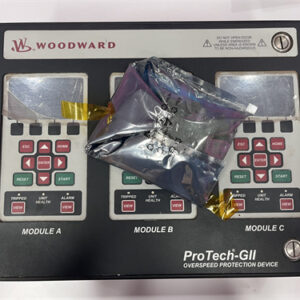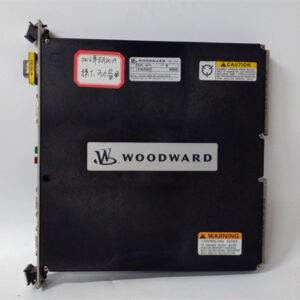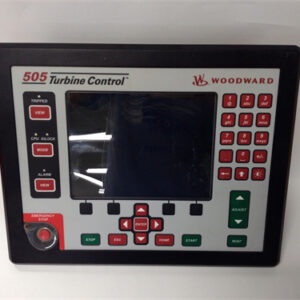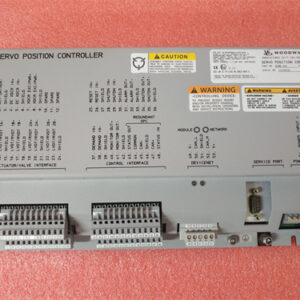الوصف
The WOODWARD 8237-2497 is a highly specialized and critical safety component within Woodward’s MicroNet Safety Module (MSM) series. It functions as a sophisticated Safety PLC with integrated overspeed protection, specifically designed to ensure the safe and reliable operation of steam, gas, and hydro turbines. It continuously monitors turbine speed and acceleration, initiating an emergency shutdown if unsafe conditions are detected.
This particular model, the 8237-2497, is characterized by its panel mount design, its ability to accept dual High Voltage (HV/HV) power inputs for robust redundancy, and its use of independent relays for its outputs. Like other MicroNet Safety Modules, it features a triple modular redundant (TMR) architecture for its inputs, ensuring extremely high reliability and fault tolerance.
Brief Product Description
The WOODWARD 8237-2497 is a MicroNet Safety Module (MSM), acting as a sophisticated safety PLC with integrated overspeed protection. Engineered for critical industrial safety applications, it precisely monitors the speed and acceleration of turbine rotors. It boasts a triple modular redundant (2-out-of-3 voted) input architecture, ensuring highly reliable and precise overspeed detection. This specific model is designed for panel mounting, supports dual High Voltage (HV) power inputs for enhanced redundancy, and employs independent output relays to issue safe shutdown commands to the turbine’s trip system. It also includes Modbus communication for seamless diagnostics and remote integration into plant control systems.
- Product Type: Overspeed Protection Device / Safety PLC Module (MicroNet Safety Module – MSM)
- Manufacturer: Woodward
- Model/Part Number: 8237-2497 (MicroNet Safety Module series)
- Primary Function: Turbine overspeed and overacceleration protection, safe shutdown, and integrated safety functions.
- Key Features: Triple modular redundancy (2oo3 voted inputs), digital speed control, independent relays, Modbus communication, panel mount, dual High Voltage (HV) power input.
Detailed Product Description
In critical industrial processes where large rotating machinery like turbines are integral to operations, preventing an uncontrolled overspeed event is paramount for safety and operational continuity. Such events can lead to catastrophic mechanical failure, severe equipment damage, and significant safety hazards. The WOODWARD 8237-2497 MicroNet Safety Module (MSM) is engineered precisely for these high-stakes environments. It’s not merely a speed monitoring device; it’s a sophisticated, highly reliable, and fault-tolerant safety system designed to provide the ultimate layer of protection for valuable turbine assets.
Consider a modern power plant where both maximum operational uptime and uncompromising safety are absolutely critical. The plant needed to upgrade its turbine overspeed protection system to adhere to the most stringent safety integrity levels and provide advanced diagnostic capabilities. The Woodward MicroNet Safety Module (MSM) series, specifically the 8237-2497, was the ideal solution. Its panel mount design allowed for efficient and clean integration into existing control room panels, simplifying wiring and minimizing installation time. The dual High Voltage (HV/HV) power inputs were a critical feature, providing essential redundant power paths that ensure uninterruptible safety functions in a system that cannot afford any downtime. Furthermore, the use of independent relays for its outputs, coupled with the triple modular redundant (TMR) inputs, ensured maximum fault tolerance. This means the system would reliably execute a trip when a genuine hazardous condition occurred, while virtually eliminating nuisance trips. This implementation significantly enhanced the plant’s overall safety posture and operational reliability.
Uncompromising Safety with Digital Control and Redundancy
The WOODWARD 8237-2497 is built upon the robust foundation of the MicroNet Safety Module (MSM) series’ advanced safety architecture, delivering superior protection:
- Digital Speed and Acceleration Monitoring: This module precisely monitors the turbine rotor’s speed and rate of acceleration. It typically receives signals from active or passive Magnetic Pick-Up Units (MPUs) or proximity probes. This digital approach ensures high accuracy and rapid response times, crucial for detecting and reacting promptly to hazardous conditions.
- Overspeed and Overacceleration Protection: Its core function is to detect when the turbine’s speed or its acceleration rate exceeds pre-defined safety setpoints. Upon detection, it quickly issues a trip command to the turbine’s emergency trip valve(s) or other shutdown mechanisms to prevent a runaway condition.
- Triple Modular Redundancy (TMR) for Inputs (2-out-of-3 Voting): This is a defining characteristic of the MicroNet Safety Module (MSM) series. The system employs three independent channels for speed sensing and processing. For a trip condition to be declared, at least two out of the three channels must independently confirm the overspeed or overacceleration event. This 2oo3 voting logic significantly enhances system reliability by minimizing the risk of nuisance trips due to a single sensor or module fault, while still ensuring a safe shutdown when a genuine hazardous condition exists.
- IEC61508 SIL-3 Certified: This certification signifies that the 8237-2497 meets the most rigorous international standards for functional safety. Achieving Safety Integrity Level 3 means the device has an extremely low probability of dangerous failure, making it suitable for the most critical Safety Instrumented Functions (SIF) in demanding industrial applications. It also adheres to industry standards such as API 670 and API 612.
- Independent Relays (Output): This model specifically features independent relays for its trip outputs. This design provides distinct, non-voted outputs that can be wired to separate trip solenoids or systems, offering flexibility for integration into various turbine trip architectures and allowing for more granular control over different shutdown actions.
Design and Features for Flexible Integration and Maintenance
The 8237-2497 is designed for practical industrial application and ease of maintenance:
- Panel Mount Design: This variant is specifically designed for flush mounting within a control cabinet or panel, providing a clean, integrated appearance. This makes it suitable for installation in control rooms or local equipment panels, offering convenient access.
- Dual High Voltage (HV/HV) Power Inputs: The module accepts two independent High Voltage (HV) power inputs (e.g., 90–240 Vac / 100–150 Vdc). This dual HV input capability is crucial for providing redundant power paths, enhancing the system’s fault tolerance and ensuring continuous operation even if one power source fails.
- Modbus Communication: Equipped with Modbus (serial) communication, the device can seamlessly integrate with Distributed Control Systems (DCS), SCADA systems, or other plant-wide monitoring platforms. This enables remote monitoring of turbine speed, alarm statuses, detailed diagnostics, and historical event logs.
- Online Testing and Repair: A significant advantage of the MicroNet Safety Module (MSM) system is its ability to perform online testing of its functionality and speed sensors without requiring a turbine shutdown. Individual modules can often be replaced while the system remains online, significantly minimizing operational downtime during maintenance.
- Comprehensive Logging: The device stores detailed historical logs of all trips, alarms, overspeed events, and trip valve response times in non-volatile memory. This data is invaluable for post-event analysis, root cause identification, and compliance reporting.
- Environmental Robustness: Engineered for harsh industrial environments, it features robust construction and often includes conformal coating to protect against common contaminants like sulfur, H2S, and SO2 gases (rated for Class 3C2 environments and typically IP56 ingress protection when properly installed).
- Integrated Display: Each module typically includes a high-resolution color display and keypad, allowing users to locally monitor configuration settings, statuses, system inputs and outputs, and alarm, trip, and overspeed logs.
Technical Specifications
Key Applications
The WOODWARD 8237-2497 is a vital safety component employed in a wide array of high-stakes industrial applications:
- Power Generation: Providing robust primary and backup overspeed protection for gas, steam, and hydro turbines in diverse power plant configurations worldwide.
- Oil & Gas: Safeguarding gas turbines driving critical compressors in pipelines, processing plants, and offshore platforms.
- Petrochemical Industry: Protecting turbine-driven machinery vital to chemical manufacturing and refining operations.
- Marine Propulsion: Used in large marine vessels for highly reliable turbine overspeed protection systems.
- Industrial Plants: Any facility that relies on large industrial turbines where safety, continuous operation, and regulatory compliance are paramount.

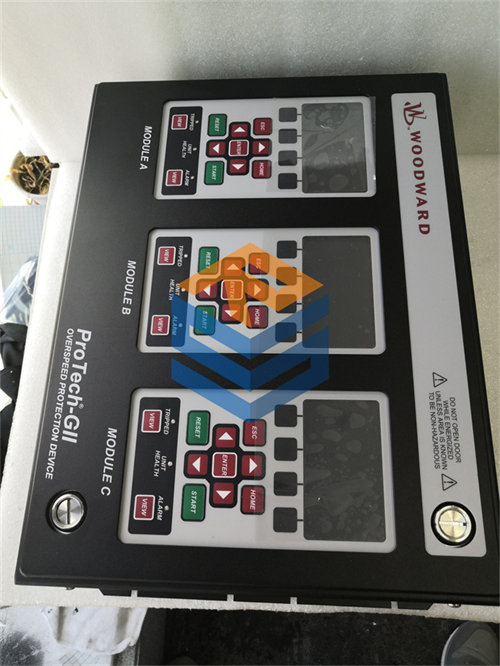

 +86 15340683922
+86 15340683922 +86 15340683922
+86 15340683922